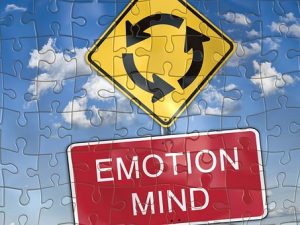
Cognitive behavioural therapy is about doing things beyond your standard behavioural patterns. Doing this will give you a new perspective on how the world works.
People love their habits, and many keep repeating what they’ve always done. This repeated behaviour includes routines, habits, and patterns. It starts with your thoughts and results in emotions and actions. New approaches are needed if you want to change the outcomes and results in your life. Einstein put it nicely when he said, “The definition of insanity is doing the same thing over and over again and expecting different results.”
A person forms his thoughts based on what they experienced. If you ask yourself why you think a certain way, it’s probably because of real-life experiences. So we use the exact mechanism to change people’s beliefs by changing their experiences. Since these factors influence each other, if we change one of our thought factors, the emotions and actions will often lead to a whole new chain.

Cognitive biases:
Cognitive biases are “thinking errors.” These include final thoughts, black-and-white thinking, or thinking in other illogical ways. A person may have numerous thinking errors and reflection incorrectly, which doesn’t represent reality, often leading to failure.
Cognitive therapy addresses this by focusing more on investigating the different thoughts and beliefs that you may have. The therapist may ask you what is the worst that can happen if you go and talk to a stranger. Point out where you have what is called cognitive biases. In cognitive therapy, speaking of “evidence” to see actual results is expected. But if your “evidence” is a failure, then it’s no surprise you think and act as you do. By thinking and acting the same, the evidence remains the same.
It is difficult for individuals to recognize their thought patterns – because they live in them! They believe it to be accurate, which is why they are there in the first place. Watching behavioural patterns that come from thinking patterns is more comfortable. Behaviour patterns are something tangible and visible to observe. The most effective therapy is probably doing cognitive therapies and C.B.T. Asking questions regarding your thoughts and doing missions.

Missions as therapy:
Cognitive-behavioural therapy focuses on changing your behaviour to see new evidence. A person will often have a session with a therapist who identifies where he can change his behaviour. He gets specific “missions” to do. By doing these missions, you will get new evidence, and these new experiences will change their limiting beliefs. The mind must believe what it experiences; as stated, new experiences come from doing new things.
But the trick is to be consciously aware of this. Most people will not try out new things consciously, breaking their habits if they have not been reflecting on the benefits of doing so. An example of doing a mission is trying to talk to a stranger and see what happens. Another new behaviour can be to say no to a person. While trying out these new missions, a person often has some tools available. Another example is that one may learn psychological tools that will increase their chances of success by influencing others.
If talking to strangers has positive outcomes, one will have new knowledge and tools for success. This will lead to greater confidence and self-belief. Better confidence makes your nervous system work more smoothly, and your body language will improve. This will lead to others getting more responsive and attracted to you. Cognitive-behavioural therapy is, in other words experimenting with your behaviour. By taking chances, you can succeed. But never taking chances is a loss. Learn how to take the initiative to social gatherings here: https://abundance7.com/taking-initiative-to-social-gatherings/

Another example in C.B.T. is choosing to react differently. Instead of repeating the response in a similar situation, change your answer. If you used to get mad, try diplomacy. If you are used to pleasing other people, and that doesn’t work, try setting boundaries. The important thing is to look at what works. The world works in terms of patterns. Try recognizing the ways that are in play all around you. If you train your brain to watch for patterns in others, seeing similar things in yourself will also be more accessible. Learn more about patterns: https://abundance7.com/how-to-be-more-unpredictable/
The average person may say Sue is like, “this and that.” They most likely don’t use patterns, but when people describe each other, they are often describing patterns. In this way, people are predictable. Because people keep repeating what they are doing unless one works actively with C.B.T. and cognitive therapy, if you work with these things, you will become more and more “unpatterned.” Another word for this is freedom. So, instead of becoming submissive when somebody criticizes you, try something different, such as looking at them directly in the eyes, straightening your back, and saying what you mean. This is another mission example.

It’s your choice if you want to follow “rules” or to have freedom of choice. The thoughts you keep repeating for yourself are “the rules” you are following. You are trapped in your thinking and behavioural patterns. If the “just do it” concept works for you, keep experimenting to “just do things.” If it doesn’t work for you, you have probably hit resistance. This is an emotional charge around the topic. It’s tough to use your will to do something you resist. It’s like driving a car with the brakes on. In these cases, it’s essential to release emotional resistance. You can also dissolve the mental blocks with cognitive therapy. (C.T.)
The critical thing in C.T. is to find nuances. For example, understanding what happened ten years ago doesn’t have anything to do with you now. Or the nuance that the person who did something to you was an idiot. Or the nuance that you have the tools now to influence and change the outcome. Another nuance is that now you are ten years older and wiser, so your chances of success are higher.
The goal is to feel good and flow in all areas and situations. Therefore, identify when you get kicked out of state and work with these situations. The identification process is easy because you feel what is unpleasant. The triggered problem targets C.T., C.B.T., T.R.E., and other therapies. Read about T.R.E here: https://abundance7.com/tre-trauma-release-excercise/.

After you have released emotional resistance to a habit, you may also experience chronic avoidance. This avoids a topic because you have always done so, even if the emotional resistance is gone and your mind has not caught up. Creative avoidance can also happen when you find creative excuses for avoiding something. It may be creative avoidance if you are rationalizing and finding smart reasons for yourself why you’re stopped from doing things. An excellent example of using cognitive behavioural therapy is how to cure electromagnetic hypersensitivity.



buy rybelsus 14mg without prescription – purchase cyproheptadine pills order cyproheptadine 4mg pills
buy augmentin 375mg without prescription – duloxetine 20mg drug order cymbalta 20mg without prescription
На этом сайте АвиаЛавка (AviaLavka) вы можете купить дешевые авиабилеты в любые направления.
Мы подбираем лучшие цены от надежных авиакомпаний.
Простой интерфейс позволит быстро подобрать подходящий рейс.
https://www.avialavka.ru
Гибкая система поиска помогает подобрать оптимальные варианты перелетов.
Бронируйте билеты в пару кликов без переплат.
АвиаЛавка — ваш надежный помощник в поиске авиабилетов!
Здесь можно узнать методы диагностики и подходы по восстановлению.
1 2 3 4 5 6 7 8 9 10 11 12 13 14 15 16 17 18 19 20 21
Отдельный раздел уделяется психологическим особенностям и их влиянию на психическим здоровьем.
Также рассматриваются эффективные терапевтические и психологические методы поддержки.
Статьи помогут лучше понять, как справляться с угнетенным состоянием в пожилом возрасте.
Центр ментального здоровья — это пространство, где каждый может найти поддержку и профессиональную консультацию.
Специалисты работают с различными проблемами, включая повышенную тревожность, усталость и психологический дискомфорт.
1 2 3 4 5 6 7 8 9 10 11 12 13 14 15 16 17 18 19 20 21
В центре используются эффективные методы терапии, направленные на восстановление внутренней гармонии.
Здесь организована комфортная атмосфера для открытого общения. Цель центра — помочь каждого клиента на пути к психологическому здоровью.
You should take part in a contest for one of the best blogs on the web. I will recommend this site!
monodox brand – doxycycline for sale online buy glucotrol 10mg pill
augmentin 625mg us – buy ketoconazole tablets duloxetine 40mg ca